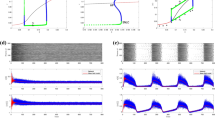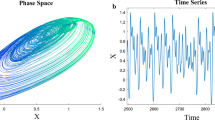Abstract
A significant aim of neuroscience and nonlinear dynamics is to understand how brain function emerges from the collective dynamics of neuronal networks. However, theoretical analysis and macroscopic understanding of neural networks are difficult because of their high dimension and computational complexity. Therefore, the concept of the mean field is proposed. Nevertheless, existing mean field models still need to improve. For example, the mean field model of neural networks composed of one-dimensional quadratic integral-and-fire (IF) neurons lacks adaptive variables and cannot simulate the necessary dynamic behavior of burst firing. The mean field of the neural network composed of the two-dimensional IF neurons lacks the expression related to membrane potential, and membrane potential is the critical variable of neural dynamics. In order to solve the above problems, this paper proposes a more accurate and comprehensive mean field model (a three-dimensional nonsmooth differential equation composed of mean membrane potential, mean adaptive variable, and mean firing rate) by using the conservation law of the number of neurons, which can not only analyze burst firing but also have expressions related to membrane potential. Moreover, the agreement degree between the original model and the derived mean field model, and the validity of this mean field model are verified by comparing the two models through numerical simulation.














Similar content being viewed by others
Availability of data and materials
The datasets generated during and analyzed during the current study are available from the corresponding author on reasonable request.
References
Sun, J., Wang, Y., Liu, P., et al.: Memristor-based neural network circuit with multimode generalization and differentiation on pavlov associative memory. IEEE Transact. Cybern. 53(5), 3351–3362 (2023). https://doi.org/10.1109/TCYB.2022.3200751
Sun, J., Wang, Y., Liu, P., et al.: Memristor-based circuit design of pad emotional space and its application in mood congruity. IEEE Internet Things J. (2023). https://doi.org/10.1109/JIOT.2023.3267778
Ma, T., Mou, J., Yan, H., et al.: A new class of Hopfield neural network with double memristive synapses and its DSP implementation. Eur. Phys. J. Plus 137(10), 1135 (2022). https://doi.org/10.1140/epjp/s13360-022-03353-8
Dou, G., Zhao, K., Guo, M., et al.: Memristor-based LSTM network for text classification. Fractals (2023). https://doi.org/10.1142/S0218348X23400406
Wilson, H.R., Cowan, J.D.: Excitatory and inhibitory interactions in localized populations of model neurons. Biophys. J. 12(1), 1–24 (1972). https://doi.org/10.1016/S0006-3495(72)86068-5
Dayan, P., Abbott, L.F.: Theoretical neuroscience. (Vol. 806), (2001)
Gerstner, W., Kistler, W.M.: Spiking Neuron Models: Single Neurons, Populations, Plasticity. Cambridge University Press (2002)
Ermentrout, B., Terman, D.H.: Mathematical foundations of neuroscience. New York: springer (2010). https://doi.org/10.1007/978-0-387-87708-2
Ashwin, P., Coombes, S., Nicks, R.: Mathematical frameworks for oscillatory network dynamics in neuroscience. J. Math. Neurosci. 6(1), 2 (2016). https://doi.org/10.1186/s13408-015-0033-6
Bressloff, P.C.: Spatiotemporal dynamics of continuum neural fields. J. Phys. A: Math. Theor. 45(3), 033001 (2012)
Coombes, S.: Waves, bumps, and patterns in neural field theories. Biol. Cybern. 93(2), 91–108 (2005). https://doi.org/10.1007/s00422-005-0574-y
Ermentrout, B.: Neural networks as spatio-temporal pattern-forming systems. Rep. Prog. Phys. 61(4), 353 (1998)
Coombes, Stephen, et al., eds.: Neural fields: theory and applications. Springer (2014)
Amari, S.: Dynamics of pattern formation in lateral-inhibition type neural fields. Biol. Cybern. 27(2), 77–87 (1977). https://doi.org/10.1007/BF00337259
Hopfield, J.J.: Neurons with graded response have collective computational properties like those of two-state neurons. Proc. Natl. Acad. Sci. 81(10), 3088–3092 (1984). https://doi.org/10.1073/pnas.81.10.3088
Mongillo, G., Barak, O., Tsodyks, M.: Synaptic theory of working memory. Science 319(5869), 1543–1546 (2008). https://doi.org/10.1126/science.1150769
Ben-Yishai, R., Bar-Or, R.L., Sompolinsky, H.: Theory of orientation tuning in visual cortex. Proc. Natl. Acad. Sci. 92(9), 3844–3848 (1995). https://doi.org/10.1073/pnas.92.9.3844
Koch, C., Segev, I. eds: Methods in neuronal modeling: from ions to networks. MIT press, (1998)
Moreno-Bote, R., Rinzel, J., Rubin, N.: Noise-induced alternations in an attractor network model of perceptual bistability. J. Neurophysiol. 98(3), 1125–1139 (2007). https://doi.org/10.1152/jn.00116.2007
Zhang, K.: Representation of spatial orientation by the intrinsic dynamics of the head-direction cell ensemble: a theory. J. Neurosci. 16(6), 2112–2126 (1996). https://doi.org/10.1523/JNEUROSCI.16-06-02112.1996
Wong, K.F., Wang, X.J.: A recurrent network mechanism of time integration in perceptual decisions. J. Neurosci. 26(4), 1314–1328 (2006). https://doi.org/10.1523/JNEUROSCI.3733-05.2006
Steyn-Ross, M.L., Steyn-Ross, D.A., Sleigh, J.W., et al.: Theoretical predictions for spatial covariance of the electroencephalographic signal during the anesthetic-induced phase transition: increased correlation length and emergence of spatial self-organization. Phys. Rev. E 68(2), 021902 (2003). https://doi.org/10.1103/PhysRevE.68.021902
Ermentrout, B., Terman, D.H.: Mathematical foundations of neuroscience. New York: springer (2010). https://doi.org/10.1007/978-0-387-87708-2
Gerstner, W., Kistler, W.M., Naud, R., et al.: Neuronal dynamics: from single neurons to networks and models of cognition. Cambridge University Press (2014)
Cowan, J.: A personal account of the development of the field theory of large-scale brain activity from 1945 onward. Neural fields. Springer, Berlin, Heidelberg, 47-96 (2014). https://doi.org/10.1007/978-3-642-54593-1_2
Coombes, S., Potthast, R.: Tutorial on neural field theory. Neural fields. Springer, Berlin, Heidelberg, 1-43 (2014). https://doi.org/10.1007/978-3-642-54593-1_1
Hodgkin, A.L., Huxley, A.F.: A quantitative description of membrane current and its application to conduction and excitation in nerve. J. Physiol. 117(4), 500 (1952). https://doi.org/10.1007/BF02459568
Morris, C., Lecar, H.: Voltage oscillations in the barnacle giant muscle fiber. Biophys. J . 35(1), 193–213 (1981). https://doi.org/10.1016/S0006-3495(81)84782-0
Ermentrout, G.B., Kopell, N.: Parabolic bursting in an excitable system coupled with a slow oscillation. SIAM J. Appl. Math. 46(2), 233–253 (1986). https://doi.org/10.1137/0146017
Izhikevich, E.M.: Resonate-and-fire neurons. Neural Netw. 14(6–7), 883–894 (2001)
Izhikevich, E.M.: Simple model of spiking neurons. IEEE Trans. Neural Netw. 14(6), 1569–1572 (2003). https://doi.org/10.1109/TNN.2003.820440
Touboul, J.: Bifurcation analysis of a general class of nonlinear integrate-and-fire neurons. SIAM J. Appl. Math. 68(4), 1045–1079 (2008). https://doi.org/10.1137/070687268
Brette, R., Gerstner, W.: Adaptive exponential integrate-and-fire model as an effective description of neuronal activity. J. Neurophysiol. 94(5), 3637–3642 (2005). https://doi.org/10.1152/jn.00686.2005
Naud, R., Marcille, N., Clopath, C., Gerstner, W.: Firing patterns in the adaptive exponential integrate-and-fire model. Biol. Cybern. 99(4), 335–347 (2008). https://doi.org/10.1007/s00422-008-0264-7
Barranca, V.J., Johnson, D.C., Moyher, J.L., et al.: Dynamics of the exponential integrate-and-fire model with slow currents and adaptation. J. Comput. Neurosci. 37(1), 161–180 (2014). https://doi.org/10.1007/s10827-013-0494-0
Montbrió, E., Pazó, D., Roxin, A.: Macroscopic description for networks of spiking neurons. Phys. Rev. X 5(2), 021028 (2015). https://doi.org/10.1103/PhysRevX.5.021028
Ott, E., Antonsen, T.M.: Low dimensional behavior of large systems of globally coupled oscillators. Chaos: An Interdiscip. J. Nonlinear Sci. 18(3), 037113 (2008). https://doi.org/10.1063/1.2930766
Devalle, F., Montbrió, E., Pazó, D.: Dynamics of a large system of spiking neurons with synaptic delay. Phys. Rev. E 98(4), 042214 (2018). https://doi.org/10.1103/PhysRevE.98.042214
Pietras, B., Devalle, F., Roxin, A., et al.: Exact firing rate model reveals the differential effects of chemical versus electrical synapses in spiking networks. Phys. Rev. E 100(4), 042412 (2019). https://doi.org/10.1103/PhysRevE.100.042412
Devalle, F., Roxin, A., Montbrió, E.: Firing rate equations require a spike synchrony mechanism to correctly describe fast oscillations in inhibitory networks. PLoS Comput. Biol. 13(12), e1005881 (2017). https://doi.org/10.1371/journal.pcbi.1005881
Nicola, W., Campbell, S.A.: Bifurcations of large networks of two-dimensional integrate and fire neurons. J. Comput. Neurosci. 35(1), 87–108 (2013). https://doi.org/10.1007/s10827-013-0442-z
Nicola, W., Campbell, S.A.: Nonsmooth bifurcations of mean field systems of two-dimensional integrate and fire neurons. SIAM J. Appl. Dyn. Syst. 15(1), 391–439 (2016). https://doi.org/10.1137/140985846
Ly, C., Tranchina, D.: Critical analysis of dimension reduction by a moment closure method in a population density approach to neural network modeling. Neural Comput. 19(8), 2032–2092 (2007). https://doi.org/10.1162/neco.2007.19.8.2032
Xie, Y., Xu, Y., Ma, J.: Desynchronization and energy diversity between neurons. Nonlinear Dyn. 111(12), 11521–11541 (2023). https://doi.org/10.1007/s11071-023-08468-w
Hou, B., Zhou, P., Ren, G., et al.: Energy flow controls synchronization in a network coupled with memristive synapses. Eur. Phys. J. Plus 138(3), 293 (2023). https://doi.org/10.1140/epjp/s13360-023-03900-x
Yang, F., Wang, Y., Ma, J.: An adaptive synchronization approach in a network composed of four neurons with energy diversity. Indian J. Phys. 97(7), 2125–2137 (2023). https://doi.org/10.1007/s12648-022-02562-2
Funding
Funding was received from the National Natural Science Foundation of China (No.12262002, No.11872154), Natural Science Foundation of Guangxi Province (2021GXNSFAA196076, 2021GXNSFFA196006), and The Guangxi Science and Technology base and Talent Project (Grant No.AD22080047).
Author information
Authors and Affiliations
Contributions
Jieqiong Xu conceived, designed, and performed the study, analyzed the data, reviewed drafts of the paper, and approved the final draft. Junjie Wang analyzed the data and authored or reviewed drafts of the paper. Qixiang Xu, Jie Fang, and Jimin Qiu analyzed the data and reviewed drafts of the paper.
Corresponding author
Ethics declarations
Conflict of interest
The authors declare that there are no competing interests.
Additional information
Publisher's Note
Springer Nature remains neutral with regard to jurisdictional claims in published maps and institutional affiliations.
Rights and permissions
Springer Nature or its licensor (e.g. a society or other partner) holds exclusive rights to this article under a publishing agreement with the author(s) or other rightsholder(s); author self-archiving of the accepted manuscript version of this article is solely governed by the terms of such publishing agreement and applicable law.
About this article
Cite this article
Xu, J., Wang, J., Xu, Q. et al. Mean field derivation and validity verification of neural networks coupled by Izhikevich neurons. Nonlinear Dyn 111, 22567–22593 (2023). https://doi.org/10.1007/s11071-023-09009-1
Received:
Accepted:
Published:
Issue Date:
DOI: https://doi.org/10.1007/s11071-023-09009-1




